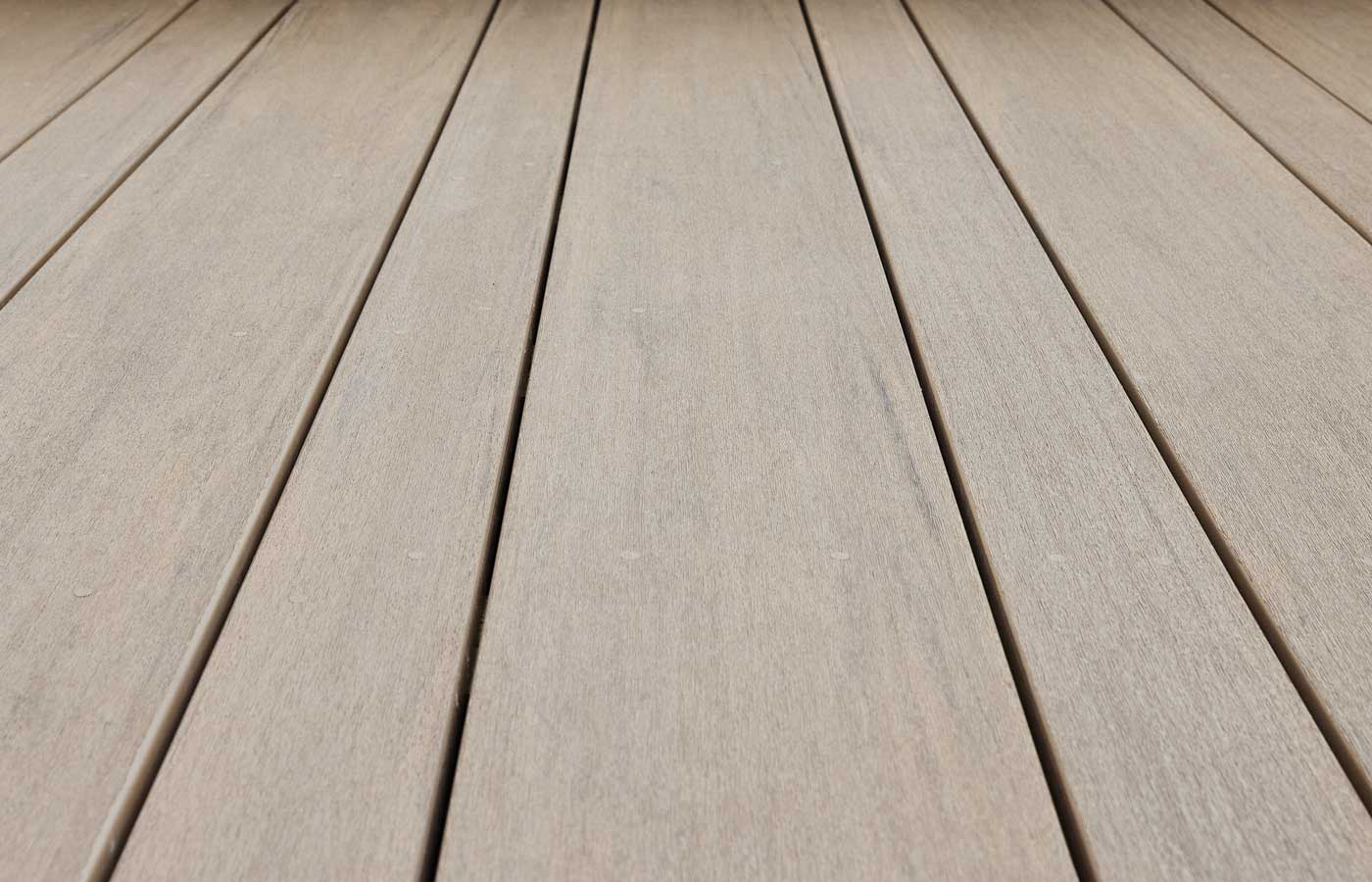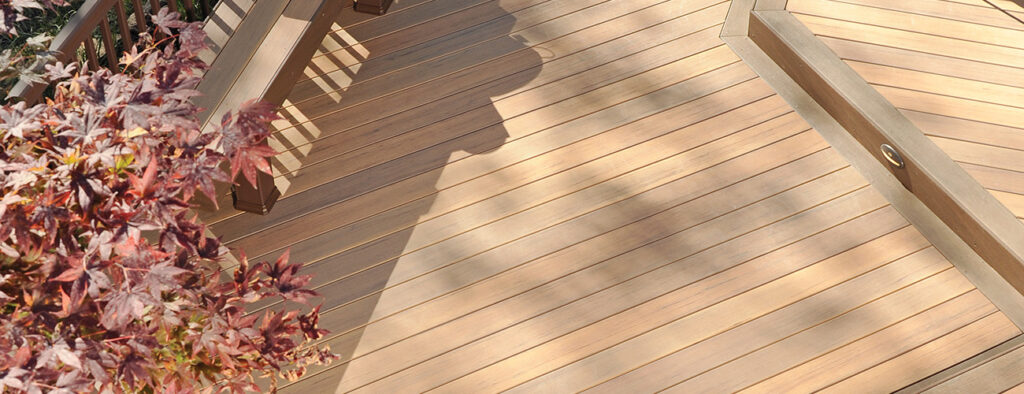While traditional wood has been a decking staple for decades, it’s certainly not your only deck material choice. If you haven’t explored newer engineered materials, you’re missing out on low-maintenance and high-performance perks that wood just can’t offer.
One of the first steps when building a deck is deciding what you’ll build it out of. It’s a big decision to make for your home and finances, so we’re comparing all the benefits and considerations for composite decking vs. wood so you decide with confidence.
Before we dig into the details, here’s a quick overview of composite and real wood decking:
| Composite | Wood |
|---|---|
| • Low maintenance • Moisture resistant • Durable and long-lasting • Versatile color and grain options • Rot and termite resistant | • Natural look • Lower upfront costs* • Ability to stain decking to a new color |
When you’re comparing your decking choices, be sure to consider:
- Durability
- Upfront and lifetime costs
- Maintenance requirements
- Aesthetics
- Lifestyle
We’ll talk about each of these items for composite and wood decking below.
In This Article:
- Composite Decking
- Real Wood Decks
- Lowest Maintenance
- Moisture Resistant
- Natural Wood Look
- Best Appearance
- Most Affordable Upfront
- Best Lifetime Value
- Easiest To Install
Composite Decking
Composite decking is manufactured with a blend of reclaimed organic wood fiber and recycled plastic, which makes it a sustainable choice for eco-minded homeowners.
Composite decking comes in two options:
- Capped composite: features protective polymer capping for improved durability and weather resistance
- Uncapped composite: made with the same core materials as capped composite but without the protective cap
Many homeowners celebrate composite decking for its low maintenance needs and strength. Capped composite boards, like TimberTech Composite™, are less susceptible to fading and water damage than real wood, and you can save time, money, and labor on annual sealer and waterproofing.
TimberTech Tip:
“Composite” is sometimes used to refer to any engineered decking alternative like TimberTech’s Advanced PVC. Here, we discuss composite decking that includes wood fibers in its core only.
Composite decking also comes in a range of color options and natural grain textures for creative and unique deck designs. While it doesn’t look exactly like real wood, composite is closing the gap to offer a natural look that’s just as beautiful.
Cost is the drawback for many homeowners. Composite decks are often slightly more expensive to purchase than wood decking, so it may be difficult to fit into an initial project budget. However, composite decks can save you hundreds on annual maintenance, and that’s not including the time cost. Its increased durability also translates into a longer lasting deck.
Composite Decking: Pros and Cons
| Pros: | Cons: |
|---|---|
| • Low lifetime costs • Durable and long-lasting • Low maintenance • Resistant to water and UV damage • Versatile color and texture choices • Superior protection with TimberTech’s 4-sided capped boards | • Higher costs upfront • Uncapped boards are less durable than capped • Not as natural-looking as real wood |
Real Wood Decks
Many people still automatically associate decks with lumber, so it’s a natural go-to for homeowners. However, there are several wood species to choose from within these core categories:
- Hardwoods: improved durability at a higher cost
Includes: Ipe, garapa, teak - Softwoods: easier to work with at a moderate cost
Includes: cedar, redwood - Pressure-treated softwoods: improved weather resistance when properly maintained with the lowest cost
The hard-to-beat benefit of lumber is that it looks and feels like wood — because it is. Composite technology is beautiful and always getting better, and other manufactured decking like TimberTech’s Advanced PVC mimics the real-wood look extremely well. But at the end of the day, real wood is your best bet if you love the look and texture of authentic wood and can cover annual maintenance.
Real wood can also be quite durable, especially if you invest in hardwood decking. However, it’s only as strong as your commitment to maintenance. Wood needs a fresh coat of sealer or paint every year or so to withstand water and UV exposure, which can cause fading, splinters, and rot. You’ll have to remove existing paint or sealer before applying a new coat.
Pressure-treated lumber is treated to reduce its weather vulnerabilities, but it’s still far less efficient than manufactured decking. It’s one of the most affordable deck materials to build with, though it’s important to understand how long-term maintenance costs add up.
Real Wood: Pros and Cons
| Pros: | Cons: |
|---|---|
| • Authentic wood look and texture • Wood types vary in cost for every budget • Typically more affordable upfront | • Must be maintained for safety and aesthetics • Less durable than manufactured options • More expensive long-term • Board variations and length limits can complicate installation |
Lowest Maintenance
If you’re looking to expand your living space — not your home maintenance chores — composite decking is the choice for you. Traditional wood, whether an exotic hardwood or basic pressure-treated lumber, demands rigorous, costly, and downright time-consuming maintenance year over year.
Manufactured decking materials don’t need sanding and sealer each year for protection. Instead, an annual deep clean and inspection will keep your deck healthy and beautiful. Cleaning a composite deck requires a specific brush and cleaner, but otherwise, it’s as easy as clearing, scrubbing, and rinsing the deck as needed.
Winner: Composite
Best for Moisture
Manufactured materials, including TimberTech’s Composite™ and Advanced PVC decking, don’t absorb moisture and are far more weather-resistant than wood. Homeowners can seal wood decks to improve water resistance, but it needs to be treated regularly and will still absorb moisture and decompose over time.
TimberTech’s Capped Composite decking fare better against moisture than uncapped decks, since the protective caps prevent moisture from accessing the decking core.
If you live near the coast or are considering waterfront decking, PVC may actually be the best material for you. PVC doesn’t contain any organic materials, so it isn’t as susceptible to water damage. That said, you’ll still need to inspect your deck’s lumber substructure for damage.
Winner: Composite
Natural Wood Look
Modern decking technology has really refined the look of composite materials to resemble wood characteristics extremely well. However, if the real-wood look is your goal, it’s tough to beat the authenticity of wood’s color and grain.
If you’d like the low-maintenance perks of manufactured decking with a look as close to natural as you can get, you may like TimberTech’s Advanced PVC material. If you’re on the fence, order free decking samples to compare material options at home.
Winner: Wood
Most Enduring Looks
You can get the rich, warm look of real wood with modern composite decking, so it may seem like a tie trying to decide which looks better. However, there’s actually a major difference between these two material aesthetics that comes down to performance.
Composite decking is more durable than wood, so it holds up against UV and water damage that can cause lumber to fade, split, and splinter. Composite decking often lasts longer and maintains its beauty for the long term, so you can install a deck you’re sure to love for years to come.
If your deck’s design is important to you, composite decking maintains its color without staining. And you can mix and match decking board colors for creative decking patterns or color schemes.
Winner: Composite
Most Affordable Upfront
Some homeowners browsing decking options may hesitate to choose composite when comparing it with lumber costs because manufactured materials are typically more expensive upfront. The actual cost of materials and installation for comparable manufactured and wood products tends to favor wood, but there are a lot of factors that impact pricing.
Material costs vary even within the broader composite decking vs. wood categories. For example, high-quality Ipe lumber is much more expensive than most manufactured decking materials, while pressure-treated pine is one of the most affordable options available.
It’s also important to consider lifetime maintenance expenses and life expectancy of your deck. But if you’re just looking at your initial project costs, budget species like pressure-treated pine are often more affordable.
Winner: Wood
Best Lifetime Value
We mentioned that manufactured materials often cost more upfront, but wood decks require regular maintenance including a new coat of sealer every one to three years. This cost adds up quickly, too.
When we compare the affordably priced pressure-treated pine with TimberTech Composite™ decking, pressure-treated pine is about a thousand dollars cheaper to purchase and install. Over 10 years, that same wood deck will cost several thousand dollars more to maintain than a composite deck.
When we calculate total costs including the initial investment and long-term maintenance, composite decking is actually over a thousand dollars cheaper than pressure-treated pine. These cost savings actually increase as you compare higher-quality lumber and manufactured decking.
Winner: Composite
Easiest To Install
How easily you can build your new deck depends more on your space and deck design than it does the actual material choice, to an extent. For example, installing cedar or composite decking will be a similar experience. However, hardwoods like Ipe can be harder to work with when sizing or drilling boards.
There are differences between the materials, but they may not be what you think. Cutting and ripping composite boards to size is just as easy as lumber. In fact, composite offers some perks in that your board sizes will be more uniform than natural wood, which means less woodworking for you or your contractor. Specific fastener and building regulations may vary between composite and wood decks.
Additionally, you won’t have to seal a new composite deck as you would real wood. Composite decks are designed to accommodate hidden fasteners, so if a seamless look is your goal, it’s easier to accomplish with manufactured deck boards.
Winner: Composite
When it comes to composite decking vs. wood, the winner is clear: TimberTech Composite™ decking beats wood in almost every feature. So, if you’re looking to invest in a stunning, long-lasting, low-maintenance deck, choose TimberTech Composite™ or Advanced PVC manufactured decking.
See the nuanced beauty and feel the durability of TimberTech decking up close with free board samples in your favorite colors. Be sure to place the samples outside to get the best sense of which colors look best in your space.







